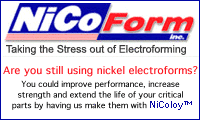
-----
Magnesium hydroxide for wastewater treatment
1996
Our jobbing shop processes mostly zinc plating - cyanide and acid chloride - and nickel/chrome plating. We have been approached by ICI to change from traditional sodium hydroxide precipitation in our effluent treatment plant to Magnesium Oxide (Naturally enough under the tag of "Enviromag"!) for all of the usual reasons that MgO outperforms other hydroxides viz. superior settling rate, increased sludge density, pH buffering etc, PLUS (the big one) the fact that wastes precipitated with Magnesium pass the leachate test without "fixing", due to the residual alkalinity.
My queries to the forum are: What are other people's experience with Magnesium? And has anyone had success with local authorities with regard to the sludges being suitable for NON-SECURE landfill?
Additionally, we are looking at alkaline non-cyanide for the still line. Is there a problem with getting deposits over 0.5 mil (12 microns)? A lot of the plating is subsequently powder coated. Any problems with adhesion and/or handling the temperature?
plating shop - Brisbane, Australia
I've been trying for years to find a good place to try magnesium hydroxide, but the residence time is so long that I haven't been able to try it yet. Howard Plating, a large jobshop in Madison Heights, Michigan, USA, uses it if I recall correctly from a feature article in a trade journal some years ago. But even with a multi-hour residence time, they still have to top off with NaOH. Plus, of course, the pH is too low for precipitation of nickel.
I'm not being negative, I'd greatly prefer to use it rather than caustic soda ⇦liquid caustic soda in bulk on
Amazon [affil link]
--just haven't figured out how yet.

Ted Mooney, P.E.
Striving to live Aloha
finishing.com - Pine Beach, New Jersey
Ted is available for instant help
or longer-term assistance.
1996
Update 12/01/08: I did employ magnesium hydroxide on a batch treatment installation in New Jersey in 1997-1998 and was happy with it as long as on-the-fly pH adjustment is not required.
It is neat stuff--But--it is unbelievably slow to dissolve. Unless you have the option of pre-dissolving it in acid rinsewaters and feeding that into your waste treatment system, it will either take what seems to be forever or you will overdose it and the pH will rise when you do not want it to. The price came down and NaOH went up so it is now affordable. It does help in the filter press.
As far as going to a non secure landfill, I think that you have to delist which is a tortuous process that might be going away. Buy a big insurance policy, because in 5 years or so, you will be blamed for the water coming out of the dump even if you encapsulated it in epoxy and have contributed nothing to the problem. You are visible and a lot of do gooders have nothing better to do. Besides, the lawyers file a class action suit and get paid.
- Navarre, Florida
1996
Mag Oxide Trials
Our trials continue after a few technical hiccups and we are co-dosing with caustic (two separate pumps) because of the lack of grunt in the MgO. We believe that we are getting enough MgO in the sludge to pass leachate tests and are currently awaiting our first test results.
Regards,
Chris
plating shop - Brisbane, Australia
1998
1998
Chris and Ted:
Here is some first-hand experience with Mg(OH)2. After months of trial-and-error and with some help from a supplier, we have a magnesium hydroxide/sodium hydroxide cycle that breaks up chelates from an alkaline cleaner and lets us consistently batch treat effluent containing up to 30% of the Cold Action Cleaner we once discussed in these pages:
reduce pH to <2 with sulfuric acid;
Add about 1 lb/100 gal of magnesium hydroxide (we buy it dry and prepare a slurry right before use). Allow to mix for 15-30 min. This brings the pH up to >5.0.
Add NaOH to raise pH to >11.0. Mix for 30 min.
Add flocculent;
Let precipitate. It usually takes anywhere from 1 to 6 H in our 500 gal treatment tank.
Transfer supernatant into pH reduction tank, lower pH and discharge. This cycle reduces the concentration of Ni(2+) down to <1.5 ppm.
Filter sludge in filter-press.
We like this cycle for its simplicity, low expenses and high tolerance to cleaners, nickel sludge dumps from anode bags and just about anything - no upsets so far, in over 6 months of using it.
Hope others will find this useful, too.

"PlaterB" Berl Stein
NiCoForm, Inc.
Rochester, New York

1998
Our sludge passed the leachate test and we are now progressing with the local authorities.
Will keep you posted.
Chris
plating shop - Brisbane, Australia
Thanks, Berl. Thanks, Chris.

Ted Mooney, P.E.
Striving to live Aloha
finishing.com - Pine Beach, New Jersey
Ted is available for instant help
or longer-term assistance.
I would like to preface my comments by saying that I am not a research person but work on the economic development side of the Manitoba government. I was searching for information on magnesium production facilities and came across your discussion. The other side of my job deals in waste management. Manitoba has a group of private sector people who are looking at ways to take the smell out of hog manure. We are interested in any process however, cost effectiveness is a main issue. So, if I can join the discussion, please educate me on some systems that are currently in use or under development. We are interested in setting up demonstration sites for those under development. Many thanks
Craig MacDonaldEconomic Development Board - Manitoba, Canada
1998
Dear Craig:
Our experience is in metal finishing, so we can't help much on the hog issue. But regarding the magnesium: plating shops usually need to (among other things) raise the pH of their effluent, both to meet discharge standards and to precipitate out the dissolved metals. This is most often done with sodium hydroxide, but sodium hydroxide is a dangerous chemical and is so rapid acting that it entraps a lot of water in the precipitation process. This is why platers are interested in magnesium hydroxide slurry, which is both safe and slower acting. Like anything else, it's not perfect: being a slurry, it clogs up the piping very easily; being only mildly alkaline, it is incapable of precipitating certain metals like nickel; being slow acting in a fast-moving world, there is often not sufficient time for it to react.

Ted Mooney, P.E.
Striving to live Aloha
finishing.com - Pine Beach, New Jersey
Ted is available for instant help
or longer-term assistance.
1998
1998
I graduated from the Ag school in New Jersey, and worked in the Plant Tissue and Soils Analysis Lab for several years. Even when it is frozen solid, poultry manure has some eye opening olfactory properties. So hog manure must be a real treat.
However, I know the answer. The most cost effective ways to eliminate complaints about hog manure are:
- open a plating shop next door
- move the hog farm to an inner city, where the residents have some real problems
- surround the farms with housing for aggie engineering graduate students, and wait for the wind to shift. (Err, Dean, I'd like to change my research project...?)
Compared to a Misplates old stripping room, hog manure ain't bad.

Tom Pullizzi
Falls Township, Pennsylvania
Q, A, or Comment on THIS thread -or- Start a NEW Thread